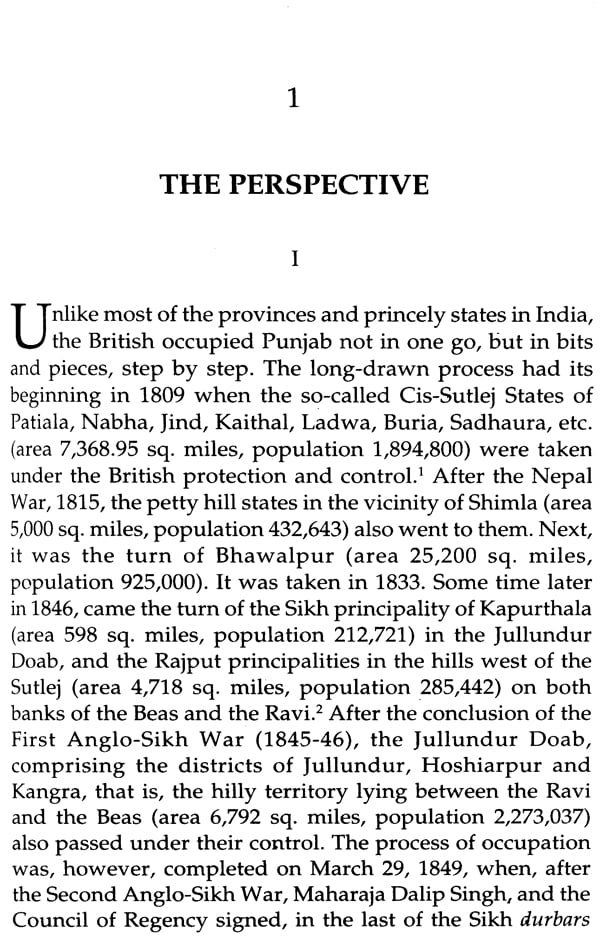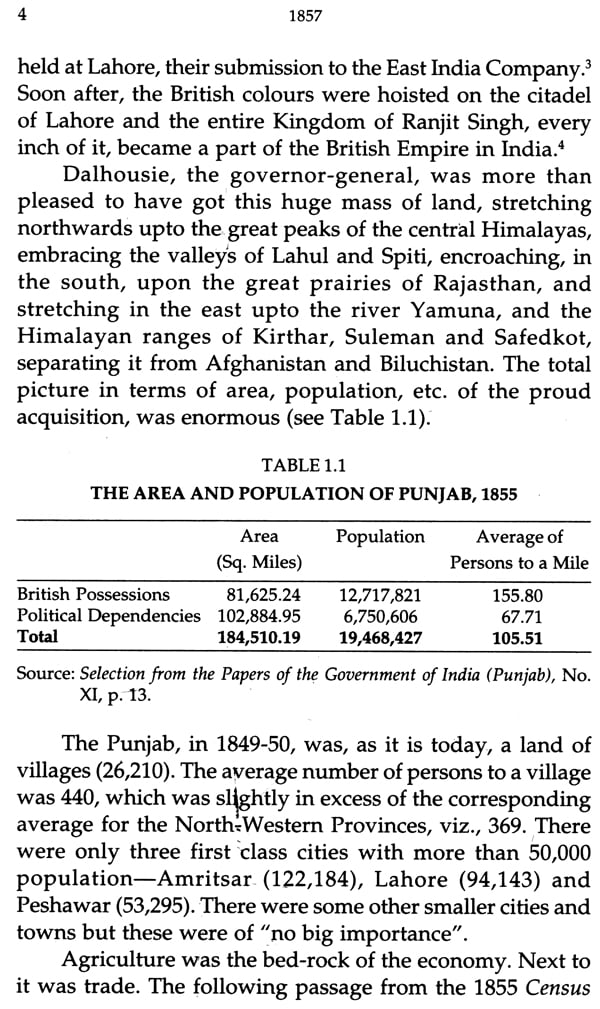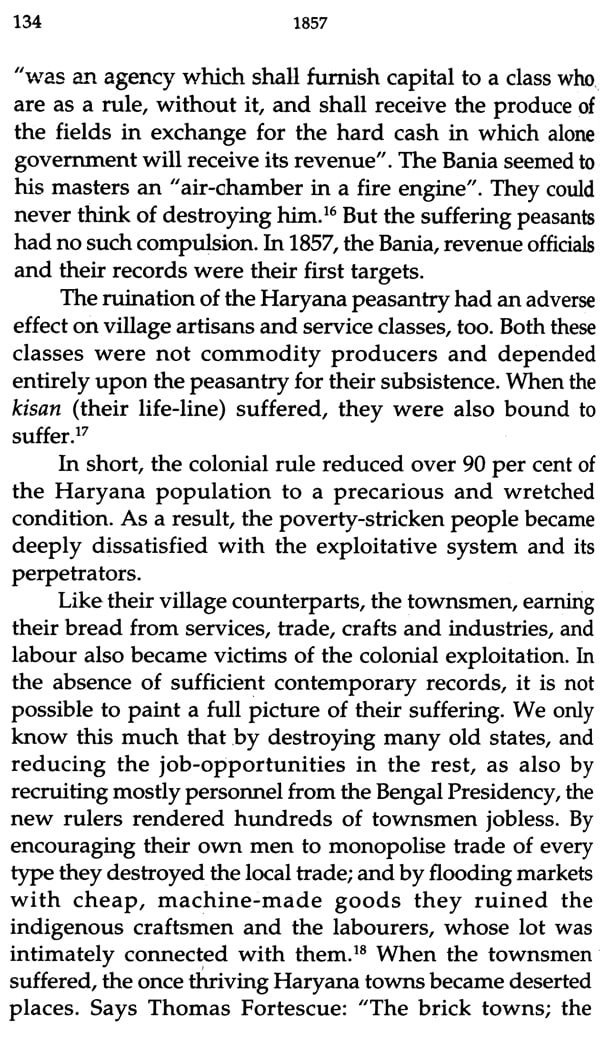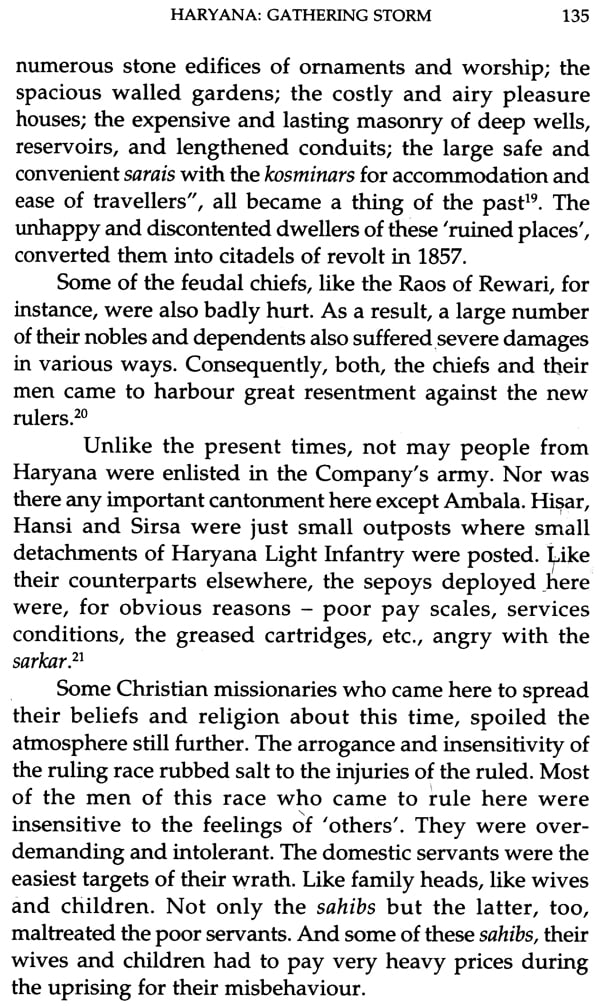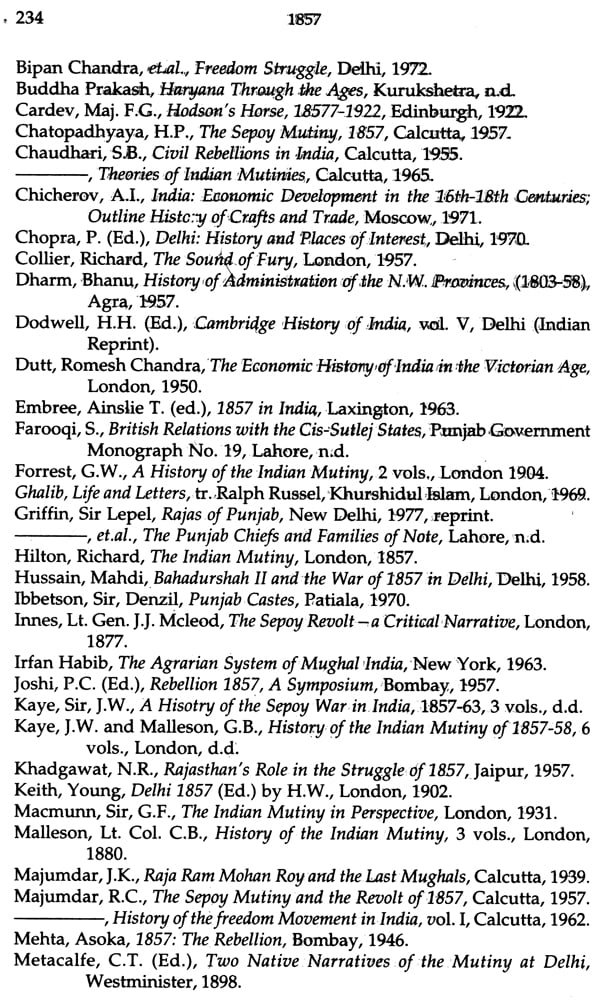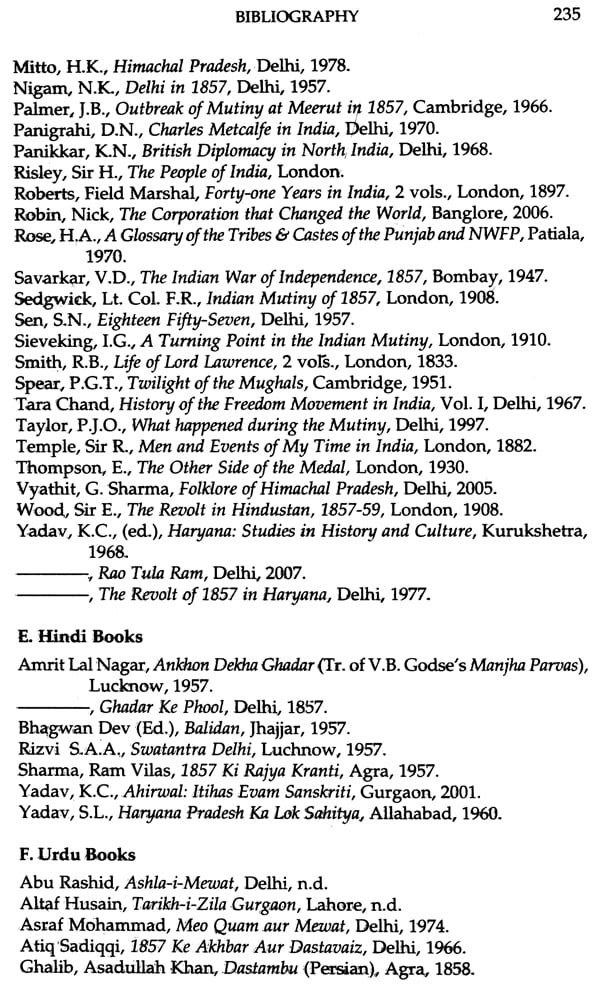
1857: The Role of Punjab, Haryana and Himachal Pradesh
Book Specification
| Item Code: | NAD366 |
| Author: | K. C. Yadav |
| Publisher: | National Book Trust, India |
| Language: | English |
| Edition: | 2015 |
| ISBN: | 9788123752778 |
| Pages: | 249 |
| Cover: | Paperback |
| Other Details | 8.5 inch X 5.5 inch |
| Weight | 440 gm |
Book Description
The book seeks to bust the myth that during 1857 movement, Punjab was ‘quiet’ and that there was hardly any ‘stir’ in Haryana and Himachal Pradesh. Taking on such a ‘one sided’ reading of the momentous events in the North India as available in the literature of the period, the book tries to establish that far from being passive or inactive, the people of these areas participated in the country’s First War of Independence with equal zeal and vigour and made ultimate sacrifices to dislodge the colonial rule. Supported with meticulous research, the book is likely to set right the chiches regarding the 1857 movement with respect to the role and contribution of the regions forming Punjab, Haryana and Himachal Pradesh.
K.C. Yadav (b. 1936) has been teaching, researching and writing history in the past four decades. He has authored/edited a number of books, published from India and abroad. Modern Indian history, specially the struggle for freedom, 1857-1947, is his forte. He taught at Kurukshetra University for over 30 years, and was visiting Research Professor at the Tokyo University of Foreign Studies for one year. Currently, he is professor at the Centre for Haryana History, Culture and Social Development, HIPA, Gurgaon.
This is an attempt to understand the role of the people of Punjab, Haryana and Himachal Pradesh in the uprising of 1857. While there is a good deal of literature on the subject, there is, regrettably, pretty little by way of a fair hearing of the case of these people. Surprisingly, even after the detailed studies by Indian historians that have started coming out, the situation has not improved. We still hear the old clichés that Punjab was ‘quiet’ in 1857, and that there was hardly any ‘stir’ in Haryana and Himachal Pradesh. In other words, the literature on 1857 stifi continues to be one-sided, echoing what John Lawrence and his countrymen had said 150 years ago.
I have tried to look here at the other side of the story, the story as seen from the receiving end of the stick. I was led to this approach by the thought-provoking writings of a soldier-cum-writer, A.H. Lind. Lind was a Swedish naval officer serving in a British regiment called the Peel’s Brigade in the traumatic days of 1857. He took part in many actions. On returning home, he read books on 1857 written by Englishmen, where, to his dismay, the facts were not reported correctly. He, therefore, wrote his recollections to set the record straight. His observations, specially on the true nature of the uprising, are worth noticing:
I found most of the people in Punjab, Haryana and Himachal Pradesh affected by such a feeling in 1857. But because of a pretty big presence of European troops (60% of their total strength in the Bengal Army) in the region, the ‘feeling’ could not be translated into a reality everywhere. At many places, where the British hold was not strong, they took chances and did their work. For example, when ‘the Second Siege Train’ was despatched from Punjab to help the British forces fighting to recapture Delhi halted at Jagraon (district Ludhiana), men from the so-called ‘lower castes’, illiterate, ignorant, and the poorest classes, the Harmis, Bawarias, Sansis, counted the number of the guns in the ‘Siege Train’ and, despite the best efforts of the district police to stop them, supplied intelligence to the rebel forces in Delhi. There are many such examples in the annals of the uprising.
There is a pretty strong myth that the Sikhs were loyal to the British during the crisis. How could they be like that? I asked. And when the facts were examined, I got the answer: They weren’t like that.
As a matter of fact, a true spirit of revolt ‘against the Firangi’ was present in the whole of the north-western region, in almost every community, caste or class. Only some ruling chiefs, their hangers-on, contractors and other beneficiaries of the British rule were loyal to the raj.
Another myth dealt with here is that the rebels had seriously lacked in organization, leadership and so forth. Surprisingly, even a serious historian like Sir John Kaye finds them to be nothing more than a “block of sacred sheep on a dusty road... huddled confusedly to their doom — objectless, rudderless, and perplexed and bewildered” (Sepoy War, vol. II, p. 312). This is, our evidence shows, absolutely untrue. The rebels were, in most of the cases, organized in as best term as possible. They had their panchayats for ‘planning’ their things and Kaths, dhars, dais, etc. for their execution. They had their leaders — natural leaders, to be precise — at different levels. Barring in some exceptional cases, both the leaders and followers knew their objective. They were not, except at some places, headless crowds acting on impulse. If it were so, one might ask, why did they fail? They failed not because of any absence of organization, leadership or clear-headedness, as some scholars would have us believe, but because their enemies’ organization, military leadership, strategies, and most importantly, fire-arms were superior.
For the sake of convenience, the present study has been divided into three parts: Part I deals with Punjab, Part II with Haryana, and Part III with Himachal Pradesh. Administratively, none of the three states was in its present shape and size in 1857. Punjab was a much bigger province—it included Punjab (India), West Punjab (Pakistan), North-Western Frontier Province (NWFP), and some parts of Haryana and Himachal Pradesh. Haryana and Himaçhal Pradesh were not separate provinces then. If things 1were like that then why, one may ask, should we divide the study into three parts? Why bring in Haryana and Himachal Pradesh when these states weren’t separate entities in 1850s? Why not to discuss the entire region as one — Punjab? There are two reasons for the present approach. One, the major part of Haryana wasn’t a part of Punjab then; it was attached to the North-Western Provinces (NWP). Had we taken old Punjab, then a considerable part of Haryana story would have gone amiss. Second, the study becomes easier and more intelligible when we take-up present states instead of old provinces which have ceased to exist.
The material for this work has been drawn from the National Archives of India, New Delhi, Punjab State Archives, Patiala and Haryana State Archives, Panchkula (Ambala). Besides this primary archival material, contemporary accounts, newspapers, memoirs, diaries, spy reports, etc. and other relevant materials, old and new, in English, Persian, Urdu and Hindi also have been used.
As for the method, the study has a narrative structure where facts speak for themselves. I don’t interfere with facts, for I know from the example of the eminent historian Sir John W. Kaye what harm an author’s unnecessary interference with his facts can do. Sir John became one with his countrymen in dealing with his facts. As a result, a gang of ruthless butchers who flooded the plains of Peshawar with innocent blood of sepoys looked “a confederacy of heroes” (The Sepoy War, vol. II; p.456), and blowing from guns a large number of men who had committed no crime appeared to be “a wonderful display of moral force” to him (ibid., p.489). This is how history becomes a farce.
A study of this kind cannot but be long and complex. I have, however, presented it in a brief and simple manner, avoiding unnecessary theoretical debates, wordy webs, jargons, clichés and so forth.
The work, difficult as it was, wouldn’t have been possible without the help and cooperation of a large number of persons. I am most grateful to Prof. Bipan Chandra, the chairman, National Book Trust, India who helped me in a number of ways to complete the project expeditiously. Prof. V.N. Datta and Dr. R.P. Maleyvar made many positive suggestions and comments, which have gone a long way in improving the text. Shri Satyaprakash Singh, Shri Surendra Singh Rao and Dr. Satish Yadav made many a helpful criticism. I am most grateful to all of them.
I must also acknowledge, with a sense of gratitude, the assistance and help of the staff of the National Archives of India, New Delhi, Punjab State Archives, Patiala, Haryana State Archives, Panchkula and Jawaharlal Nehru Museum and Library, New Delhi. My thanks are also due to the National Book Trust, India, New Delhi for making the book a quality publication.
| Preface | ix | |
| Part One: Punjab | ||
| 1 | The Perspective | 3 |
| 2 | Gathering Storm | 13 |
| 3 | The Rising (I) | 30 |
| 4 | The Rising (II) | 61 |
| 5 | Role of the Sikhs | 96 |
| 6 | Conclusion | 111 |
| Part Two: Haryana | ||
| 1 | Historical Perspective | 121 |
| 2 | Gathering Storm | 129 |
| 3 | The Rising (I) | 138 |
| 4 | The Rising (II) | 168 |
| 5 | Conclusion | 191 |
| Part Three: Himachal Pradesh | ||
| 1 | The Perspective | 203 |
| 2 | Gathering Storm | 209 |
| 3 | The Rising | 215 |
| 4 | Conclusion | 228 |
| Bibliography | 231 |
